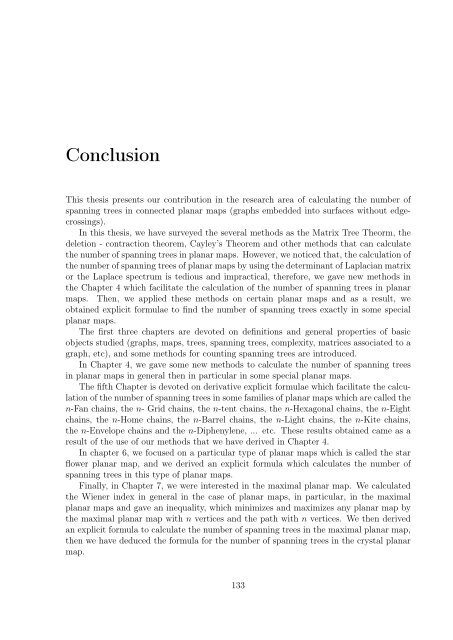enumeration of the number of spanning trees in some ... - Toubkal
enumeration of the number of spanning trees in some ... - Toubkal
enumeration of the number of spanning trees in some ... - Toubkal
Create successful ePaper yourself
Turn your PDF publications into a flip-book with our unique Google optimized e-Paper software.
ConclusionThis <strong>the</strong>sis presents our contribution <strong>in</strong> <strong>the</strong> research area <strong>of</strong> calculat<strong>in</strong>g <strong>the</strong> <strong>number</strong> <strong>of</strong><strong>spann<strong>in</strong>g</strong> <strong>trees</strong> <strong>in</strong> connected planar maps (graphs embedded <strong>in</strong>to surfaces without edgecross<strong>in</strong>gs).In this <strong>the</strong>sis, we have surveyed <strong>the</strong> several methods as <strong>the</strong> Matrix Tree Theorm, <strong>the</strong>deletion - contraction <strong>the</strong>orem, Cayley’s Theorem and o<strong>the</strong>r methods that can calculate<strong>the</strong> <strong>number</strong> <strong>of</strong> <strong>spann<strong>in</strong>g</strong> <strong>trees</strong> <strong>in</strong> planar maps. However, we noticed that, <strong>the</strong> calculation <strong>of</strong><strong>the</strong> <strong>number</strong> <strong>of</strong> <strong>spann<strong>in</strong>g</strong> <strong>trees</strong> <strong>of</strong> planar maps by us<strong>in</strong>g <strong>the</strong> determ<strong>in</strong>ant <strong>of</strong> Laplacian matrixor <strong>the</strong> Laplace spectrum is tedious and impractical, <strong>the</strong>refore, we gave new methods <strong>in</strong><strong>the</strong> Chapter 4 which facilitate <strong>the</strong> calculation <strong>of</strong> <strong>the</strong> <strong>number</strong> <strong>of</strong> <strong>spann<strong>in</strong>g</strong> <strong>trees</strong> <strong>in</strong> planarmaps. Then, we applied <strong>the</strong>se methods on certa<strong>in</strong> planar maps and as a result, weobta<strong>in</strong>ed explicit formulae to f<strong>in</strong>d <strong>the</strong> <strong>number</strong> <strong>of</strong> <strong>spann<strong>in</strong>g</strong> <strong>trees</strong> exactly <strong>in</strong> <strong>some</strong> specialplanar maps.The first three chapters are devoted on def<strong>in</strong>itions and general properties <strong>of</strong> basicobjects studied (graphs, maps, <strong>trees</strong>, <strong>spann<strong>in</strong>g</strong> <strong>trees</strong>, complexity, matrices associated to agraph, etc), and <strong>some</strong> methods for count<strong>in</strong>g <strong>spann<strong>in</strong>g</strong> <strong>trees</strong> are <strong>in</strong>troduced.In Chapter 4, we gave <strong>some</strong> new methods to calculate <strong>the</strong> <strong>number</strong> <strong>of</strong> <strong>spann<strong>in</strong>g</strong> <strong>trees</strong><strong>in</strong> planar maps <strong>in</strong> general <strong>the</strong>n <strong>in</strong> particular <strong>in</strong> <strong>some</strong> special planar maps.The fifth Chapter is devoted on derivative explicit formulae which facilitate <strong>the</strong> calculation<strong>of</strong> <strong>the</strong> <strong>number</strong> <strong>of</strong> <strong>spann<strong>in</strong>g</strong> <strong>trees</strong> <strong>in</strong> <strong>some</strong> families <strong>of</strong> planar maps which are called <strong>the</strong>n-Fan cha<strong>in</strong>s, <strong>the</strong> n- Grid cha<strong>in</strong>s, <strong>the</strong> n-tent cha<strong>in</strong>s, <strong>the</strong> n-Hexagonal cha<strong>in</strong>s, <strong>the</strong> n-Eightcha<strong>in</strong>s, <strong>the</strong> n-Home cha<strong>in</strong>s, <strong>the</strong> n-Barrel cha<strong>in</strong>s, <strong>the</strong> n-Light cha<strong>in</strong>s, <strong>the</strong> n-Kite cha<strong>in</strong>s,<strong>the</strong> n-Envelope cha<strong>in</strong>s and <strong>the</strong> n-Diphenylene, ... etc. These results obta<strong>in</strong>ed came as aresult <strong>of</strong> <strong>the</strong> use <strong>of</strong> our methods that we have derived <strong>in</strong> Chapter 4.In chapter 6, we focused on a particular type <strong>of</strong> planar maps which is called <strong>the</strong> starflower planar map, and we derived an explicit formula which calculates <strong>the</strong> <strong>number</strong> <strong>of</strong><strong>spann<strong>in</strong>g</strong> <strong>trees</strong> <strong>in</strong> this type <strong>of</strong> planar maps.F<strong>in</strong>ally, <strong>in</strong> Chapter 7, we were <strong>in</strong>terested <strong>in</strong> <strong>the</strong> maximal planar map. We calculated<strong>the</strong> Wiener <strong>in</strong>dex <strong>in</strong> general <strong>in</strong> <strong>the</strong> case <strong>of</strong> planar maps, <strong>in</strong> particular, <strong>in</strong> <strong>the</strong> maximalplanar maps and gave an <strong>in</strong>equality, which m<strong>in</strong>imizes and maximizes any planar map by<strong>the</strong> maximal planar map with n vertices and <strong>the</strong> path with n vertices. We <strong>the</strong>n derivedan explicit formula to calculate <strong>the</strong> <strong>number</strong> <strong>of</strong> <strong>spann<strong>in</strong>g</strong> <strong>trees</strong> <strong>in</strong> <strong>the</strong> maximal planar map,<strong>the</strong>n we have deduced <strong>the</strong> formula for <strong>the</strong> <strong>number</strong> <strong>of</strong> <strong>spann<strong>in</strong>g</strong> <strong>trees</strong> <strong>in</strong> <strong>the</strong> crystal planarmap.133

















